Indo-Pakistani War of 1947
The Indo-Pakistani War of 1947–1948, sometimes known as the First Kashmir War, was fought between India and Pakistan over the princely state of Kashmir and Jammu from 1947 to 1948. It was the first of four wars fought between the two newly independent nations. Pakistan precipitated the War a few weeks after independence by launching tribal lashkar (militia) from Waziristan in an effort to wrest Kashmir from India.[7] The result of the war still affects the geopolitics of both countries.
On 22 October 1947 the Pakistani armed forces crossed the border with the claim that they needed to suppress a rebellion on the southeast of the kingdom.[8] Local tribal militias and the Pakistani forces moved to take Srinagar but on reaching Uri they encountered defensive forces. Hari Singh made a plea to India for assistance and signed the Instrument of Accession.[8] The British government also took part in stopping the Pakistani forces from advancing.[8]
The war was initially fought by the forces of the princely state and tribal militias from the Khyber Pakhtunkhwa and Federally Administered Tribal Areas.[9] Facing the assault and a Muslim revolution in the Poonch and Mirpur area,[9][10] the ruler of princely state of Kashmir and Jammu signed an Instrument of Accession to the Indian union. Indian and Pakistani armies entered the war subsequently.[9] The fronts solidified gradually along what came to be known as the Line of Control. A formal cease-fire was declared at 2359 hours on the night of 1/2 January 1949.
On 22 October 1947 the Pakistani armed forces crossed the border with the claim that they needed to suppress a rebellion on the southeast of the kingdom.[8] Local tribal militias and the Pakistani forces moved to take Srinagar but on reaching Uri they encountered defensive forces. Hari Singh made a plea to India for assistance and signed the Instrument of Accession.[8] The British government also took part in stopping the Pakistani forces from advancing.[8]
The war was initially fought by the forces of the princely state and tribal militias from the Khyber Pakhtunkhwa and Federally Administered Tribal Areas.[9] Facing the assault and a Muslim revolution in the Poonch and Mirpur area,[9][10] the ruler of princely state of Kashmir and Jammu signed an Instrument of Accession to the Indian union. Indian and Pakistani armies entered the war subsequently.[9] The fronts solidified gradually along what came to be known as the Line of Control. A formal cease-fire was declared at 2359 hours on the night of 1/2 January 1949.



.jpg)

.Ships.jpg)
























.jpg)
.jpg)
+Armed+Forces+Troops+Soldier+sniper+Karabiner+98k+HK+PSG1+M82+Barret+Steyr+SSG+69+109+107marksman+tribal+Operation+Rah-e-Nijat+Waziristan+Administered+Tribal+Areas+War+(3).jpg)
.jpg)










.jpg)
.jpg)



